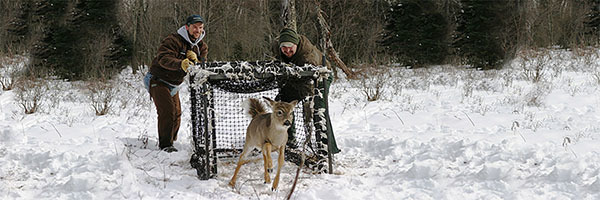 Contact: APHISpress@usda.gov
WASHINGTON, April 20, 2021. The U.S. Department of Agriculture’s Animal and Plant Health Inspection Service (APHIS) is making available up to $5.6 million for states and Tribal governments to further develop and implement Chronic Wasting Disease (CWD) management and response activities in wild and farmed cervids (e.g., deer, elk).
State departments of agriculture, state animal health agencies, state departments of wildlife or natural resources, and Federally recognized Native American Tribal governments and organizations are eligible to submit funding proposals that further develop and implement CWD management, response and research activities, including surveillance and testing. The funding can also be used to support education and outreach activities to increase awareness about the disease and how it spreads. APHIS may give priority to states and Tribal governments that have already detected CWD or border CWD endemic areas; and have either implemented monitoring and surveillance programs or propose to do so.
“APHIS’ Veterinary Services and Wildlife Services personnel are committed to working with our state and Tribal partners to control and prevent Chronic Wasting Disease in our Nation’s farmed and wild cervids,” APHIS Administrator Kevin Shea said. “These collaborative efforts will strengthen our ability to find and implement new solutions as part of our mission to safeguard agriculture and natural resources.”
CWD is an infectious, degenerative disease of cervids that causes brain cells to die, ultimately leading to the death of the affected animal. The incubation period can be long depending on species and genetic factors. Infected animals look healthy until the end stages of the disease, making them difficult to distinguish from healthy animals. Animals infected with CWD can transmit the disease to other animals during the “silent” incubation period. The disease has spread widely and the limited number of tools, as well as tool effectiveness, impacts the ability to effectively control the disease.
An eligible applicant may submit multiple proposals for each funding opportunity, requesting up to the maximum amount for that funding opportunity in each proposal. Applications will be reviewed, and funding decisions will be announced prior to October 1, 2021.
Specifically, these cooperative agreement opportunities will allow for state departments of agriculture, state animal health agencies, state departments of wildlife or natural resources and Federally recognized Native American Tribal governments and organizations to further develop and implement CWD management and response activities in accordance with the following priorities:
- improving CWD management of affected farmed herds and wild cervid populations;
- improving CWD management of affected areas or premises;
- conducting additional research on amplification assays, including the validation of the RT-QuIC assay;
- conducting additional research on predictive genetics; and,
- developing and/or delivering educational outreach materials or programs.
Funding opportunity announcements are posted on ezFedGrants and Grants.gov and can be found by searching the title, catalog of federal domestic assistance number, or funding opportunity number (see below). Applications are due in June, and specific deadlines vary.
|
Funding Opportunity Title
|
Catalog of Federal Domestic Assistance Number
|
Funding Opportunity Number
|
Application Due Date
|
|
FY21 Farmed Cervid CWD Management and Response Activities
|
10.025, Plant and Animal Disease, Pest Control and Animal Care
|
USDA-APHIS-10025-VSSPRS00-21-0108
|
June 19, 2021 at 11:59 PM Eastern Daylight Savings Time
|
|
FY21 Wild Cervid CWD Management and Response Activities
|
10.028, Wildlife Services
|
USDA-APHIS-10028-WSNWRC00-21-0008
|
June 19, 2021 at 11:59 PM Eastern Daylight Savings Time
|
|
FY21 Tribal Nations Wild Cervid CWD Opportunities
|
10.028, Wildlife Services
|
USDA-APHIS-10028-WSNWRC00-21-0009
|
July 4, 2021 at 11:59 PM Eastern Daylight Savings Time
|
#
USDA touches the lives of all Americans each day in so many positive ways. In the Biden-Harris Administration, USDA is transforming America’s food system with a greater focus on more resilient local and regional food production, fairer markets for all producers, ensuring access to safe, healthy and nutritious food in all communities, building new markets and streams of income for farmers and producers using climate smart food and forestry practices, making historic investments in infrastructure and clean energy capabilities in rural America, and committing to equity across the Department by removing systemic barriers and building a workforce more representative of America. To learn more, visit www.usda.gov.
|